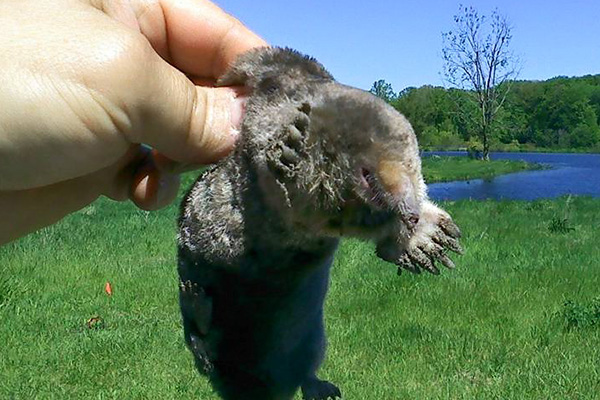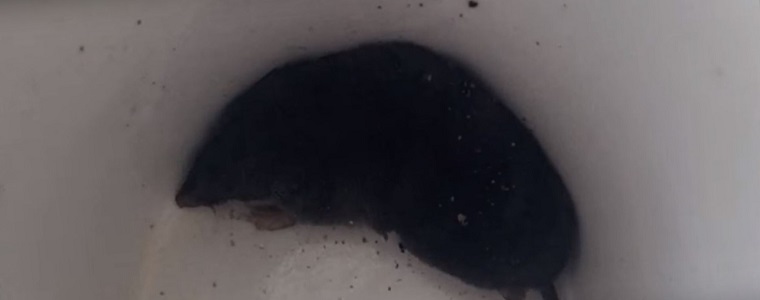-
info@aaanimalcontrol.com
Call us for help in your town
Humane Wildlife Education
Things To Know About a Mole's Biology, Diet, Life Cycle
Need mole removal in your hometown? We service over 500 USA locations! Click here to hire us in your town and check prices - updated for year 2020.
Kingdom: Animalia
Phylum: Chordata
Class: Mammalia
Order: Soricomorpha
Family: Talpidae
There are about 20 species of moles but they mostly have the same physical appearance with little variations, especially in their colors. Some of the popular species are star nosed mole, hairy tailed mole, eastern mole, European mole, broad-footed mole, American shrew mole, coast mole, Townsend mole etc. They feed their young ones with milk and are warm blooded, hence they are mammals.
Need mole removal in your hometown? Click here for our nationwide list of hundreds of
wildlife removal experts, serving all 50 states!
Appearance
Moles are mammals with a compact but narrow body frame that is covered with short thick furs in a wide range of
colors from brownish grey to black. Usually, they are as small as mice and the male mole (boars) is bigger than its female counterpart (sow). An average male measures 18 cm in length while the female measures an average of 16 cm.
Moles have tiny eyes which are almost entirely covered with fur and as a result, their vision is poor; they also have no external ears. They however possess a sharp sense of smell, courtesy of a long snout on which their noses are situated. The long snout also helps moles to locate their foods easily. The large, curved claws on the toes of their front feet are adapted for burrowing and they can dig underground tunnels as long as 18 cm in just one hour.

Behavior
Moles are solitary creatures from the day they leave their mothers, only coming together at mating periods. Each mole has a defined territory and their occasional meetings are usually marked with fierce rivalry. They are busy mammals as they spend most of their time finding and storing foods; an activity that gets intensified during the raining periods. Moles do not hibernate, but are active all through the year.
Diet
Moles are mostly insectivorous in nature. They typically feed on ants, worms, centipedes, slugs, insects and other organisms found in the soil like snails. The only species that eats small fishes and crustaceans is the star nosed mole, which lives inside ponds and near streams. Large moles are also known for eating mice sometimes.
Moles use their snout - a protruded portion of the head region that contains nose and mouth, to find food and retrieve it from under the ground. They use a poison found in their saliva to paralyze the insect before storing it in their underground homes. Moles have a great appetite and eat at regular intervals all through the day. They are believed to eat between 70 to 100% of their body weight each day and eat a total of over 50 pounds of worms each year.
Life cycle
The mating season of moles is from February to April each year. After a gestation period of between 4 to 6 weeks, the sow gives birth to 2 to 7 pups. Thus, with a lifespan of 4 to 6 years, a sow can give birth to an average of 25 pups during her lifetime. The little pup lives with its mother for about 4 to 5 weeks after birth, during which time it is fed with milk, and afterwards moves out to start fending for itself. Moles reach maturity and start breeding by 10 months.
Although the average lifespan of a mole is 5 years, it can be affected by environmental conditions and predation. The natural predators of moles are dogs, cats, owl, hawks, coyotes, badgers, etc. They also get killed on few occasions by spades when a gardener is working on the yards, lawns, or farmyards farmyards over their tunnels.
Habitat
Moles can be found almost everywhere depending on their species as different species are adapted to different habitats. They are predominantly found in parts of Africa, Europe, North America and Asia. As long as a place is good enough to be burrowed, moles can survive there. Moles can be found in woodlands, wet meadows, pasture, marshes, temperate forest, hayfields, dry places and even near ponds and streams. They are very good at making burrows and underground tunnels in any of these habitats and live most of their solitary lives there.
The only places that moles cannot live in are areas characterized by hard, semiarid soil. Digging and
tunneling in these places would be a difficult feat.
Go back to the main how to get rid of moles page for better information. Read about mole trapping to learn about how
mole control is done, and please be aware that it isn't easy for amatuers. Mole trapping requires a great deal of experience. You may be wondering if there are other ways outside of trapping to learn
how to kill a mole but there really aren't. You'll need lethal traps like spear traps or scissor traps. Finally, are there some ways to modify your
lawn or property? A little. Read about mole prevention here.
Did you know that a collective group of moles are called a “labor”? The females have the same name as female pigs too — sows, and the males are known by the name boar. You’d think that they’ have youngsters that were called piglets, but this is not the case. Despite the pig-style references to names for their mothers and fathers, baby moles are actually called pups, and they are usually born 2-5 to a litter, in the middle of spring — March and April.

The breeding seasons change depending on the species of moles that you are talking about, and also where in the world you find this animal, but the pregnancies seem to last for about 4-6 weeks. When the animals are around the same old — 4 to 6 weeks — they are ready to leave the nest and start life on their own. And they really will go off to start life on their own too. They aren’t really known to be the most sociable creatures on the planet, and they will often fight if they are in close proximity to each other, particularly males around the breeding seasons.
Moles have adapted to life underground, even being able to breathe without difficulty in high carbon monoxide areas, such as within those tunnel systems underground. They’re quite amazing creatures, long and cylindrical in shape, and very much like an almost-blind rat that lives under the ground. They aren't a rodent though. Moles are small mammals, and they’re omnivores too, eating stuff that they easily find in the soil as they are building tunnels. Earthworms, nuts, and seeds are all on the menu, but earthworms does seem to be the favorite. So much so, in fact, that the creature will stockpile them just in case. The long tunnels make for a great trap for prey, as well as a great home to live in, allowing animals to simply fall in and become stuck or disorientated. The mole runs along, bites the worm, injects a powerful toxin that keeps the worm alive, but paralyzes it, and then either eats it immediately, or stores in a pantry, of sorts, underground. It sounds like something out of a horror movie, just proving that fact is often stranger than fiction. Things get even stranger when you learn that the mole will literally force any mud inside the worm’s body out, by squeezing the invertebrate through its paws.
The coat of this creature is quite unique, with a velvety finish that isn’t found in many wild critters, and this lead to a fashion trend during the time of Edward VII of the United Kingdom, and his beautiful bride, Queen Alexandria. She reportedly ordered a coat to be made up of the underground, soft creatures, and it enabled Scotland to turn what had become a rather nasty pest control issue into a flourishing industry. Moles are still hunter for their furs today, but the subject of fur-wearing is a well-debated one. It some senses, it could be argued that this pest creature has the potential to do a lot of damage when the population numbers are not kept under control. In fact, in many countries around the world, the humble mole is seen as a pest.
For more information, you may want to click on one of these guides that I wrote:
How to Get Rid of Moles
how much does mole removal cost?
Read more about:
How to Get Rid of Moles via underground fences and trapping
What kind of damage do moles cause to a lawn?
What is a mole hill? Describe mole tunnels


















